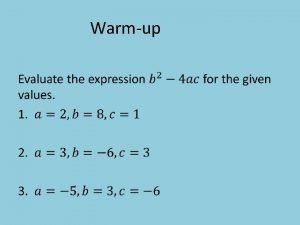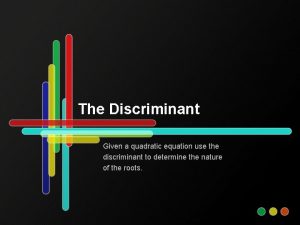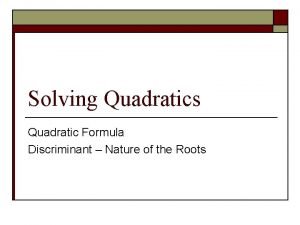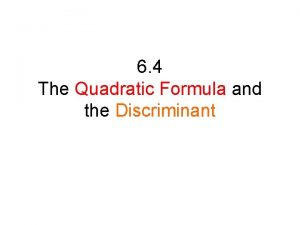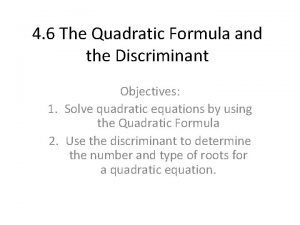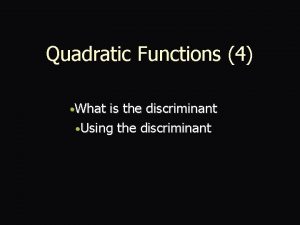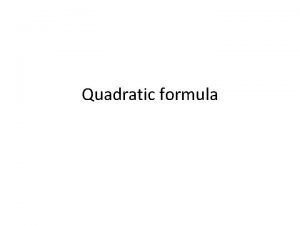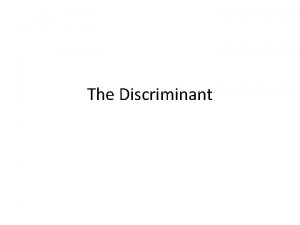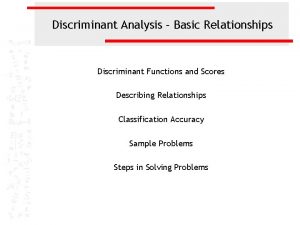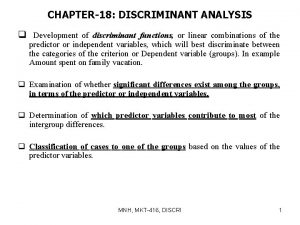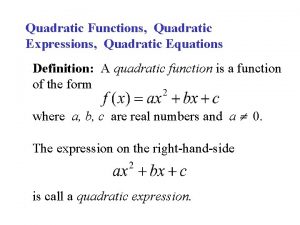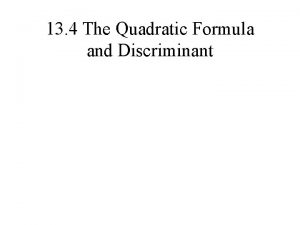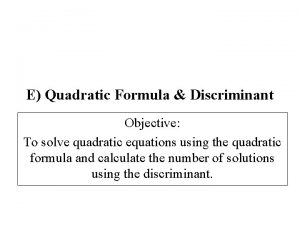Quadratic Functions 4 What is the discriminant Using










- Slides: 10

Quadratic Functions (4) • What is the discriminant • Using the discriminant

25 = 1 = (92) = (-4) = In +5 or -5 +1 or -1 +9 or -9 can’t do What can we say about. . . To get a solution for x ?

What can we say about. . . In If it’s negative then it has no solutions ---> cannot square root a negative number If it’s zero then it only has only solution

The discriminant This is the discriminant of the equation ax 2+bx+c=0

Using the discriminant The discriminant can be used to give us important information about the roots of our quadratic. The “roots” are basically our solutions when ax 2+bx+c=0 Roots

Which is which? b 2 -4 ac = 0 b 2 -4 ac < 0 b 2 -4 ac > 0 b 2 -4 ac < 0 b 2 -4 ac = 0 b 2 -4 ac > 0

Using the discriminant If b 2 -4 ac > 0 Equation has two distinct roots. If b 2 -4 ac < 0 Equation has no real roots. If b 2 -4 ac = 0 Equation has repeated roots.

How it is used - example Calculate the discriminant of 2 x 2+7 x+7=0 and hence prove 2 x 2+7 x+7 is always > 0 a = [coefficient of x 2] = 2 b = [coefficient of x] = 7 c= [constant] =7 If b 2 -4 ac < 0 b 2 - 4 ac = 72 – (4 x 2 x 7) = 49 - 56 = -7 Equation has no real roots. Therefore, doesn’t cross the x-axis and is always positive

How it is used - example For what values of ‘k’ does the equation 2 x 2 -3 x+k=0 have real roots If b 2 -4 ac > 0 Equation has two distinct roots. a = [coefficient of x 2] = 2 b = [coefficient of x] = -3 c= [constant] =k b 2 - 4 ac > 0 (-3)2 – (4 x 2 x k) > 0 9 – 8 k >0 9 > 8 k 9/8 > k k < 9/8

Have a go For what values of ‘k’ does the equation 3 x 2 + 5 x+k=0 have no real roots If b 2 -4 ac < 0 Equation has no distinct roots. a = [coefficient of x 2] = 3 b = [coefficient of x] = 5 c= [constant] =k b 2 - 4 ac < 0 52 – (4 x 3 x k) < 0 25 – 12 k < 0 25 < 12 k 25/12 < k k > 25/12
 Quadratic discriminant
Quadratic discriminant Discriminant of a quadratic equation
Discriminant of a quadratic equation حل معادله درجه 2
حل معادله درجه 2 Pop goes the weasel math song
Pop goes the weasel math song Quadratic formula discriminant
Quadratic formula discriminant Find the discriminant
Find the discriminant Quadratic function discriminant
Quadratic function discriminant 8-9 the quadratic formula and the discriminant
8-9 the quadratic formula and the discriminant Quadratic function formula
Quadratic function formula Linear discriminant analysis spss
Linear discriminant analysis spss Intercept form
Intercept form
